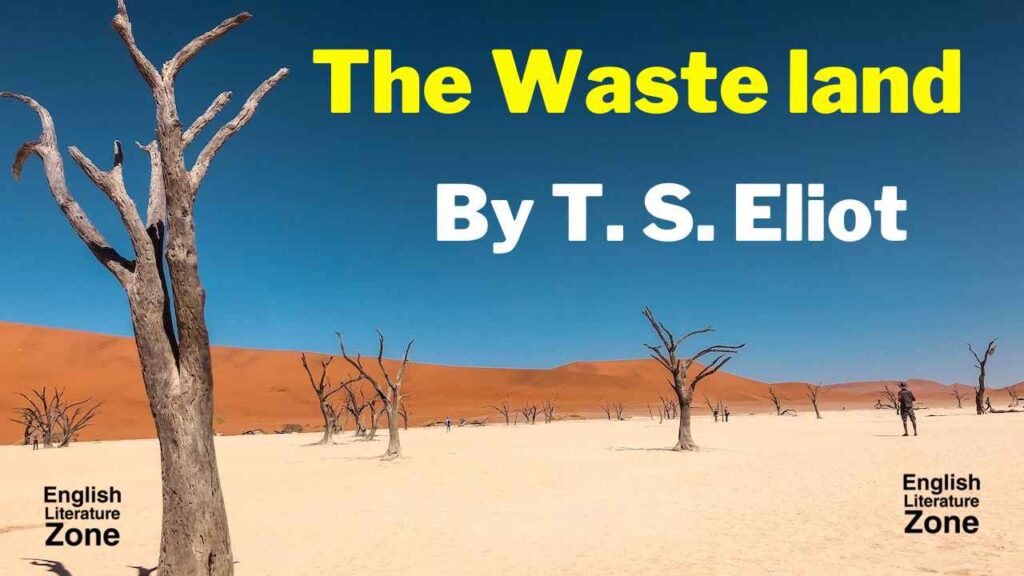
Introduction
T. S. Eliot’s The Waste Land has a special position in the history of English Poetry. It is one of the most famous poems of the 20th century. The poem is written in five parts and is often called, a poem in five fragments, but all the parts are connected with the theme of the disillusionment of a Generation and the Futility of Moden life. The poem became famous due to the techniques that Eliot used to convey his message. The poem was published in 1922. It was the time of Modernism. Modernism was a movement in which artists and writers tried to find novel methods of observation, new methods of getting knowledge, and leaving behind every established rule. The Poem The Waste Land is written in the full spirit of Modernism.
The poem “The Waste Land” is divided into five parts:
- The Burial of the Dead
- A Game of Chess
- The Fire Sermon
- Death by Water
- What the Thunder Said
. It opens with an intriguing epigraph dedicated to Ezra Pound It consists of 434 lines and it’s regarded as one of the longest poems, if not the longest, in English literature. It is a highly complex poem
About T. S. Eliot
T. S. Eliot, full name Thomas Strean Eliot was one of the significant poets of the 20th Century. There are descriptions of modern society in his poems. He received the Nobel Prize in 1948. He was a keen student of philosophy and took an exceptional interest in Indian and Hindu philosophy. In 1911 he wrote his first major poem The Love Song of J Alfred Prufrock. Among his world-famous poem included – The Waste Land, Ash Wednesday, Four Quartets, The Journey of the Magi, The Hollow Men, Morning at the Window, Little Gidding, and The Hippopotamus.
Themes Of the Poem
The Waste Land had five main themes:
- Death, that is not only physical but also Spiritual and Moral.
- “Loss of High Culture” because modern man does not have faith in the culture and traditions of his past.
- Rebirth, the image of barren and dry land brings hopelessness to the poem but is countered by the hopeful image of “Rebirth”.
- Physical Love, there is a lot of love relations shown in the poem.
- Spiritual Dryness, the modern man is breathing and walking but does not have the spiritual element intact. He is Spiritual Dry.
Analysis Of The Waste Land
At the first of the poem an aristocratic lady, she talks about her happy past days. After the speaker talks about the image of love in modern times, which is fixed upon lust and physical needs only. It is no spirituality left in it. The next speaker talks about a woman who is a card reader named Madame Sosostris. She foreshadows that water will bring death and that men should fear it. She also talks about how she is forced to carry out her business in secret.
The scene changes again, and the speaker describes the condition of ordinary men in modern times. He says that a lot of people are walking in the streets of London, but they have lost their vitality. They seem alive but are dead inside. The speaker then recollects a meeting with a soldier during a war. One soldier asks the other whether the corpse he buried in his garden has sprouted or not.
The next section, A Game of Chess opens with a description of a well do lady and the room she is sitting in. The room is laden with a lot of beauty products and perfumes. She is sitting on a burnished chair waiting for someone scattered among the artificial objects of ornamentation, there are a few glimpses of the past. When the person whom she is waiting for arrives, they indulge in meaningless dialogue.
In the next section, the speaker discussed a meeting of two underprivileged ladies sitting in a bar. They are talking about a woman name Lil. She says that her husband is returning after a long time serving in the army. They show their concern about their appearance of Lil as she has not treated her teeth and has lost her charm.
Therefore, they think that her husband will try to find recompense in other women. While these women are talking, the keeper of the bar repeatedly tells them to hurry up because the time is over. Towards, the end, the two women depart.
The third section named “The Fire Sermon” opens with the description of a dirty place by a riverside. The river is filled with garbage and rats are pushing themselves here and there. The speaker tries to catch fish in this river and thinks about his father and brother. He recalls how both of them died in the same manner. In the next setting, the speaker narrates an event when he was invited to homosexuality. He says that a merchant gave him the offer to have dinner with him and spend the weekend with him.
The next speaker narrates about a hectic day for a female typist. She is a young lady and works till late. She comes home after work and the dirty dishes from breakfast wait for her in her room. She cleans the mess and waits for her lover. The lover comes, and they indulge in sexual activities. The typist shows no emotion when the deed is being done.
At the end of this section, there is the happier image of a church, a bar, and the river Thames. The speaker recalls the love affair between “The Earl of Leicester and Queen Elizabeth”. Then, there is a confession of the lady of modern times who talks about her affairs with many men.
The fourth Section is named Death By Water. The speaker says that Phlebas the Phoenician has died by drowning in water and that his body has lost connection with the outside world. In the same manner, the speaker warns, the reader’s bodies will lose connection with the world and they will die. Therefore they should remember their own deaths.
In the Last Section named What The Thunder Said the speaker talks about the condition of modern man. He says that modern men move around in cities but have lost their human vitality. They are unreal human beings. They might walk and work like living humans but they are dead from the inside. Therefore, cities like London, Vienna, Athens, Jerusalem, and Alexandria, where these unreal humans live, have also become unreal.
Suddenly the speaker describes the condition of the east. He says that it is going to rain near the Ganges. Here the three aspects of thunder according to Hindu mythology are introduced. The first means “Give”, the second means “Sympathize” and the third means “Control”. The poem ends with the repetition of the word “Shantih”.
“Datta, Dayadhvam and Damyanta
Shantih, Shantih, Shantih”.
Conclusion
So, The Waste Land is still the most influential poem of our age: “nothing else so truly reflects the age and redeems it.” F.R. Leavis, Matthiessen, and Cleanth Brooks, the distinguished critics of the present age, have penetrated into The Waste Land and have of the opinion that The Waste Land is a highly condensed epic of the modern age. Cleanth Brooks remarks that the poem is:
“a sigh for the vanished glory of the past;
the living death of the modern waste landers”.




